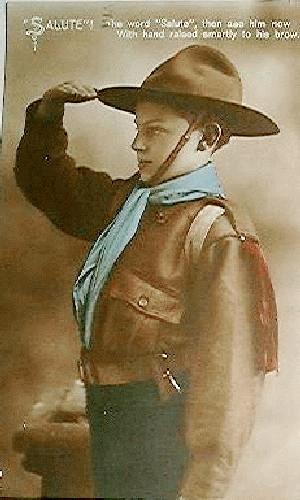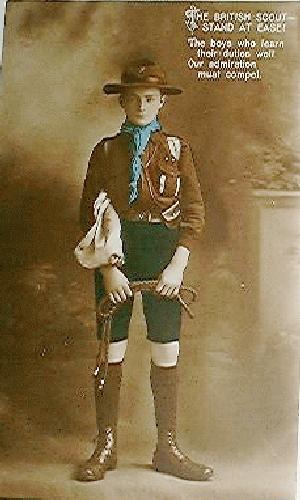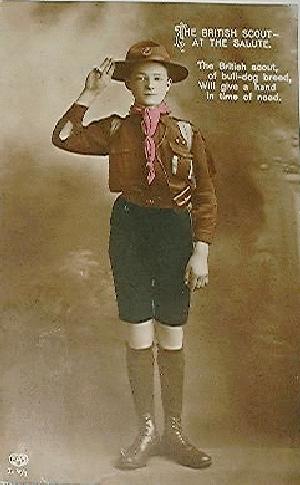
English Boy Scout Uniforms: Post Card Series (The 1910s)

Figure 1.--This English Scout in 1922 demonstrates a rather military looking salute. American Scouts employed only three fingers. He is wearing the trade-mark Scout hat that became the most recognizable symbol of Scouting around the world. The first card read, ""Salute"! The word "Salute", then " see him no With hand raised smartly to his brow".
|
A series of postcards from about 1912 provide us some interesting insights on English Scouting in the years immediately following World War II. The campaign hat
continued to be the single most destinctive elelment of the English Scout uniform and it was adopted by Scouts all over the world. The images also provide a look a
the Scout salute, the walking stick (pervsive in early Scouting), and a little poetry added by the card publishers--interestingly a German company despite the most British images. We know of four photographic postcards bearing the picture of two British Scouts. The pubishers added a lottle patriotic poetry. There may have been more to the series. An E-bay seller dated the cards to 1922 because one was postally used in that year. It is very unlikely that cards for the British market, however, would gave been published in Germany so soon after World War I. Almost ceratinly these cards were printed before the War.
Patriotic Poertry
The first card read, "Salute"! The word "Salute", then " see him no With hand raised smartly to his brow". The second card raed, "A British Scout. The bonny British scouts, today Ambition fire their hearts we pray". The third card read, " The British Scout - Stand At Ease! The boys who learn their duties well Our admiration must compel". The fourth card read, "The British Scout - At The Salute. The British scout, of bull-dog breed, will give a hand in time of need".

Figure 2.--A stout walking stick was varried by most British Scouts in the 1920s. This English Scout in 1922 demonstrates another form of the Scout salute. Notice the lack of badges and the red tab hanging down from the shoulder epaulette. The second card read, "A British Scout. The bonny British scouts, today Ambition fire their hearts we pray".
|
Publisher
All four cards were published by E.A. Schwerdtteger & Co. London E. C printed at their works in Berlin.
Chronology
An E-bay seller dated the cards to 1922 because one was postally used in that year. It is very unlikely that cards for the British market, however, would gave been published in Germany so soon after World War I. Almost ceratinly these cards were printed before the War. A British collector writes, "I have a couple of these Boy Scout Postcards in my collection too and can confirm that they were published in the early 1910s because one was was postally used in 1915. Another clue to their age is the fact that the cards, though in English, were in fact printed in Berlin by the German publisher noted above. This definitely dates them as pre-World War I as the outbreak of hostilities in August 1914 brought an end to this trade. I would guess they date from around 1912 at least."

Figure 3.--This English Scout appars to have mpore short badges than the first Scout in fiagures 1 and 2. The third card read, " The British Scout - Stand At Ease! The boys who learn their duties well Our admiration must compel". I am not sure what he is carrying.
|
Uniform
The English Scout uniform in the 1910s consisted of a campaign hat, light colored shirt, dark short pants, and kneesocks. Many boys wore laynards, but I'm not sure what they signified. The campaign cap hat continued to be the single most destinctive elelment of the English Scout uniform and it was adopted by Scouts all over the world. This hat is called a campaign or Smokey Bear hat in the United States. I'm not sure what the Englush called it. One name was a "lemon squeezer" The hat came with a leather chin strap. In practice the chin strap was often not used. The Scout scarfe was another important element of the uniform and was normally a solid color. I am not sure what color or colors were worn. The colored scarfe shown here is some colorized pot cards is probably an arbitrary choice by the colorizer in the post card plant. Notice the different ways in which the two boys pictured in this Scouting postcard series wear their scarves. The military style shirt had epauletes and pockets with button flaps. The back pack straps are worn under the shirt epaulets. We notice no badges on the fitst Scout, although there may be a pen on the collar (figures 1 and 2). The second Scout seems to have some badges, but we can not make out what they were (fifures 3 and 4). The first Scout wears some kinds of tab down from his shoulder epauletes which have been colored red (figure 2). I'm not sure precisely what this signified. The forst Scout wears an open-faced leather belt with attachments afixed
to it. One looks like the attachment for a pocket knife but he is nothing attached. The gat an short are a brown khaki color. The knee-length shorts appear to be a dark blue. The kneesocks are a khaki brown to match the shirt.

Figure 4.--This English Scout demonstartes the Scout three-finger greeting sign. The fourth card read, "The British Scout - At The Salute. The British scout, of bull-dog breed, will give a hand in time of need".
|
Colorization
These postcards are not, of course, color photographs. They are black and white or sepia tone prints that have been hand colorized. The colors here look somewhat realistic, but often in this process the colors had no relationship to the colors of the clothes worn by the children. The reader should vare this in mind, especially the colors of the scarves.
Christopher Wagner

Navigate the Historic Boys' Uniform Chronology Pages:
[Return to the Main chronologies page]
[The 1900s]
[The 1910s]
[The 1920s]
[The 1930s]
[The 1940s]
[The 1950s]
[The 1960s]
[The 1970s]
[The 1980s]
[The 1990s]
[The 2000s]
Navigate the Historic Boys' Uniform Web Site:
[Activities]
[Biographies]
[Chronologies]
[Countries]
[Essays]
[Garments]
[Organizations]
[Religion]
[Other]
[Introduction]
[Bibliographies]
[Contributions]
[FAQs]
[Questions]
[Unknown images]
[Boys' Uniform Home]
Navigate the Historic Boys' Uniform Web organization pages:
[Return to the Main English Scout uniform 1910 chronology page]
[Return to the National Scout page]
[Boys' Brigade]
[Camp Fire]
[Hitler Youth]
[National]
[Pioneers]
[Royal Rangers]
[Scout]
Created: February 25, 2000
Last updated: December 19, 2002






